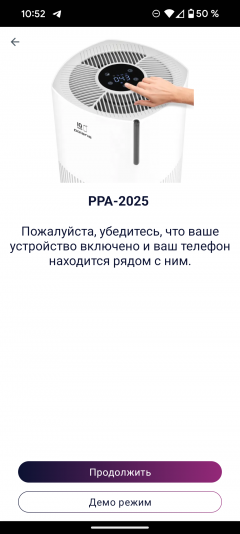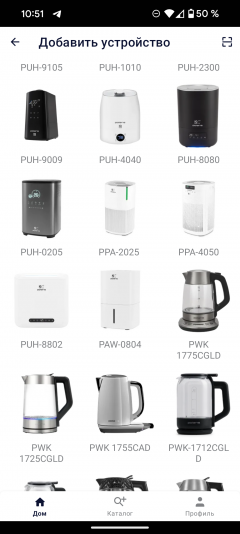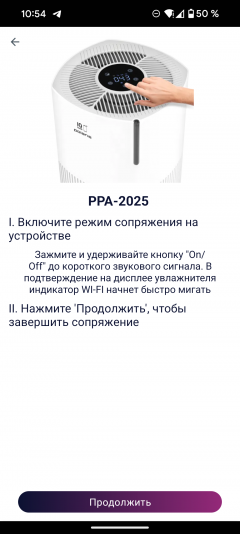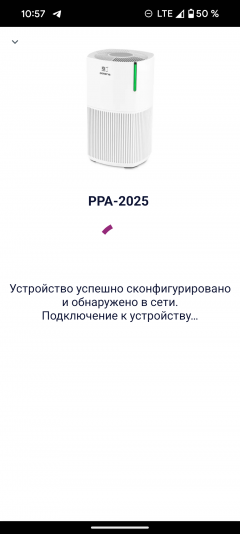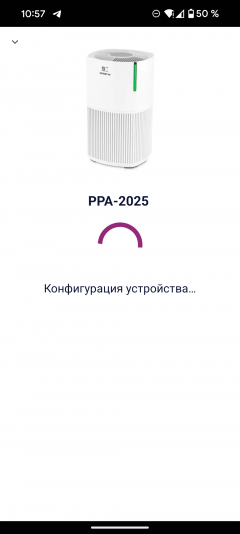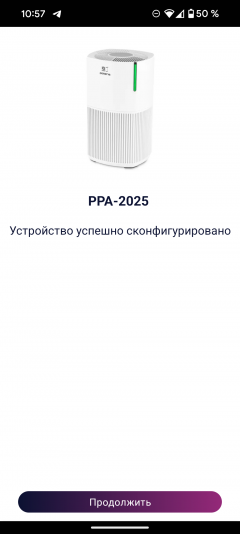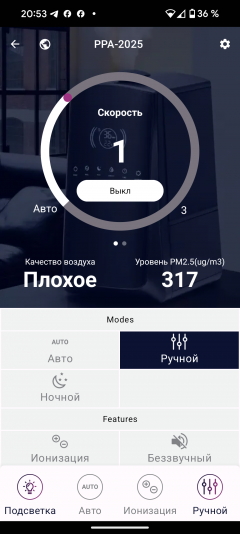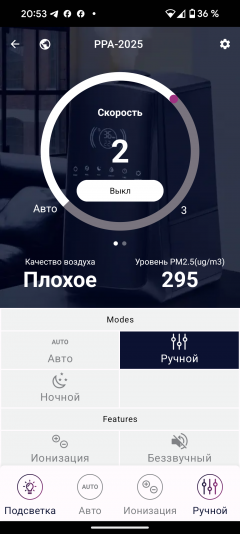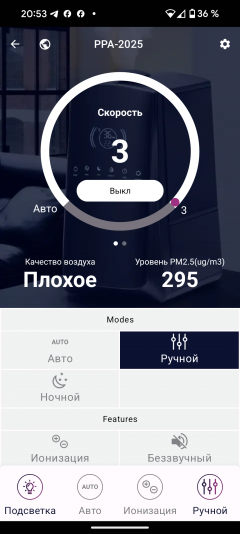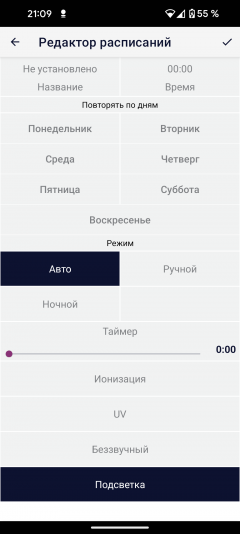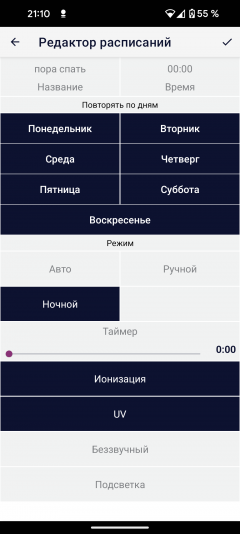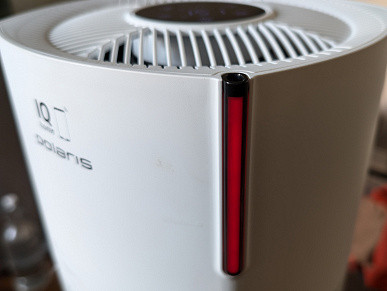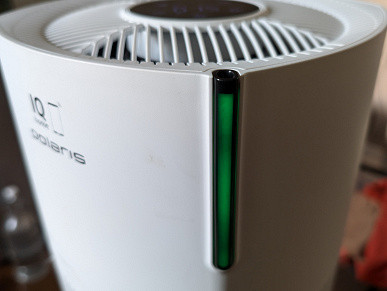Residents of apartments with windows facing noisy streets are well aware of the problem of dust. It not only settles on furniture, but also penetrates the respiratory tract. A similar situation is observed in houses with a large number of books.
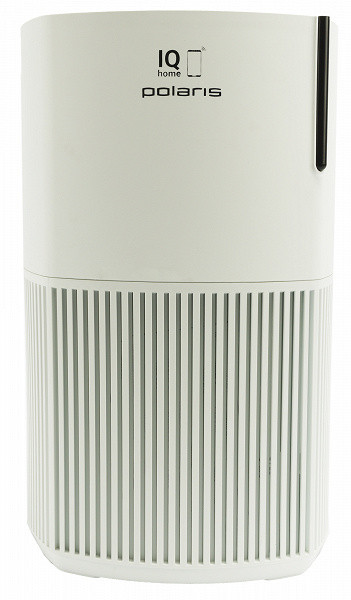
We don’t recommend you give up books or change your apartment – it’s better to use an air purifier. Start with a compact model like the Polaris PPA 2025 WiFi IQ Home, which can be controlled from anywhere in the world via the Internet. Let’s take a closer look at its benefits during testing.
Characteristics
| Manufacturer | Polaris |
|---|---|
| Model | PPA 2025 WiFi IQ Home |
| Type | air purifier |
| Country of origin | China |
| Guarantee | 3 years |
| Service life * | 3 years |
| Recommended area | 20 m² |
| Performance | 250 m³/hour |
| Number of air flow speeds | 3 |
| Automatic mode | There is |
| HEPA filter class | H13 |
| Ionizer | There is |
| Carbon filter | There is |
| Air quality sensor | There is |
| Photocatalytic filter | There is |
| Pollution level indication | There is |
| UV sterilization | There is |
| Timer | up to 12 o'clock |
| Night mode | There is |
| Control from smartphone | There is |
| Noise level | up to 56 dB |
| Weight | 3.9 kg |
| Dimensions (W×H×D) | 254×445×254 mm |
| Length of network cable | 1.6 m |
* Contrary to popular belief, this is not a period after which the device will necessarily break down. However, after this period, the manufacturer ceases to bear any responsibility for its functionality and has the right to refuse to repair it, even for a fee.
Equipment
The PPA 2025 air purifier comes in a large cardboard box with full-color printing. On the front side there is a photo of the device in operation, and next to it is an image of a smartphone with an open proprietary application. This emphasizes that Wi-Fi control is one of the key features of this model.
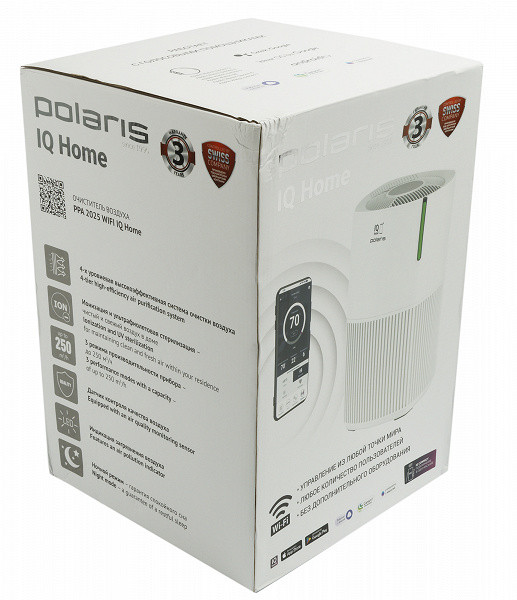
The packaging also highlights features such as unlimited users, remote access to the device from anywhere in the world, and no need for additional devices for connection.
In addition, the packaging includes the standard Polaris mentions of a three-year warranty and Swiss origin of the manufacturer.
Detailed technical specifications of the air purifier are located on the sides of the package. Here they mention a four-level highly efficient air purification system, ionization and ultraviolet sterilization functions, three performance modes with the ability to clean up to 250 cubic meters per hour, as well as an air quality control sensor with an indicator of the level of pollution and a night mode.
When opening the box, we found the air purifier itself assembled, a power supply, and a user manual.
At first glance
The Polaris PPA 2025 WiFi IQ Home air purifier, like many other similar devices, is made of white plastic. Its body has the shape of a vertical cylinder. On the front panel of the device there are stickers that describe its communication capabilities. One of the stickers has a QR code for installing the application. After synchronization with the mobile phone, these stickers can be removed.
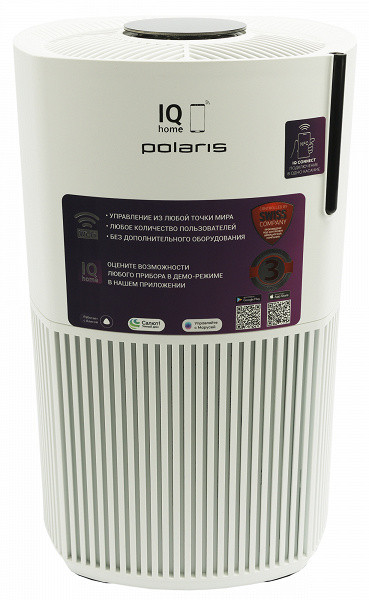
On the right side of the front panel is an original air quality indicator — an oblong element made of dark plastic that lights up during operation and changes color depending on the level of pollution. We will take a closer look at its functionality when we turn on the device.
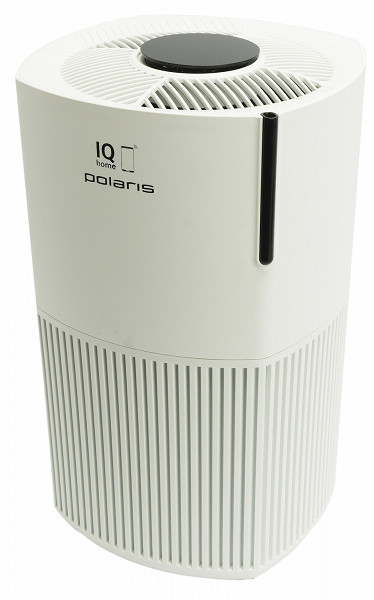
The top of the device is mostly occupied by the exhaust grille. In the center is a round control panel with an LED display and a touch button, protected by dark plastic that hides the markings when the device is turned off.
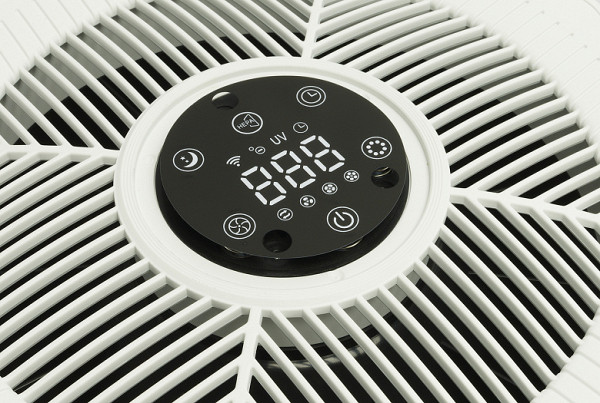
Our air cleaner arrived with a minor manufacturing defect: the double-sided tape holding the screen in place wasn't glued tight enough. We used this opportunity to take a photo of all the indicators on the panel, then pressed the protective plate down to make sure it was now firmly in place.
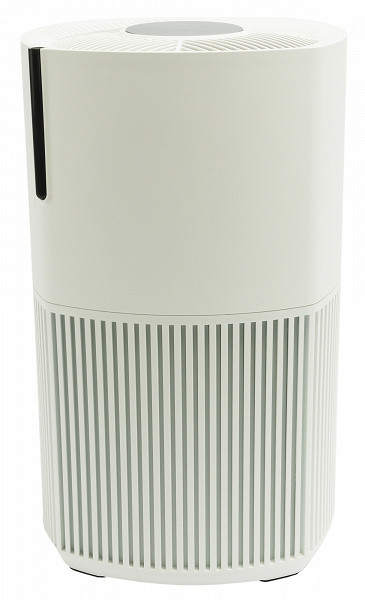
The intake grilles are located around the perimeter of the body and occupy exactly half the area of its side walls.
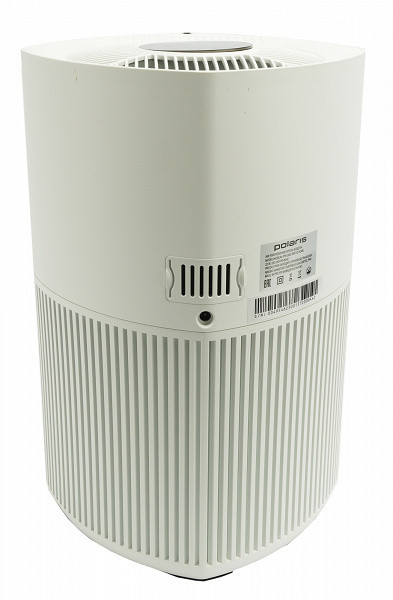
The nameplate with the factory data is located on the back wall. Next to it are the power supply connector and the air quality sensor compartment.
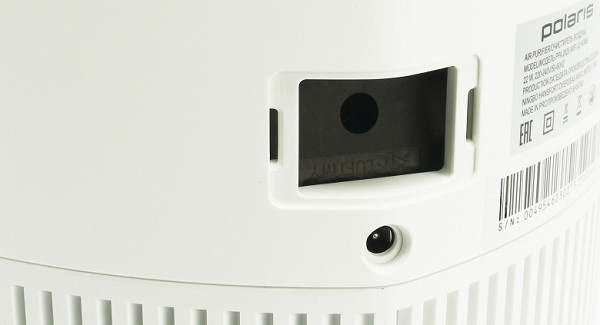
Access to the suspended particle sensor is covered by a separate plastic cover with latches.
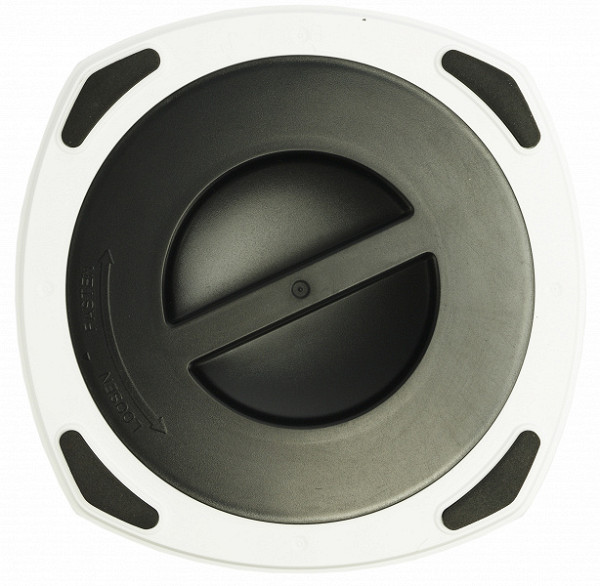
Turning the air purifier over, we found a black cover — this is a filter element that can be removed by turning the structure counterclockwise. Inside is a multi-layer cylindrical cartridge. A thin nylon mesh on the outer surface provides preliminary protection from larger dust particles.
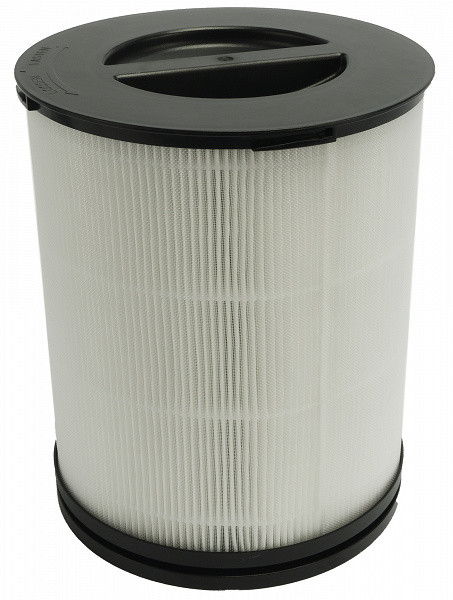
The HEPA element of class H13 is responsible for cleaning the air from suspended impurities — pollen, soot, smoke. According to the specification, filters of this class retain 99.95% of PM2.5 particles.
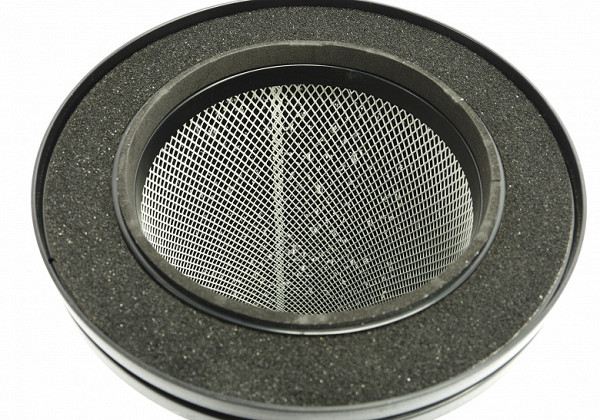
The air, purified from micropollution, passes through the third filter. Activated carbon capsules, placed in hexagonal cells, are designed to eliminate unpleasant odors by absorbing unwanted organic matter.
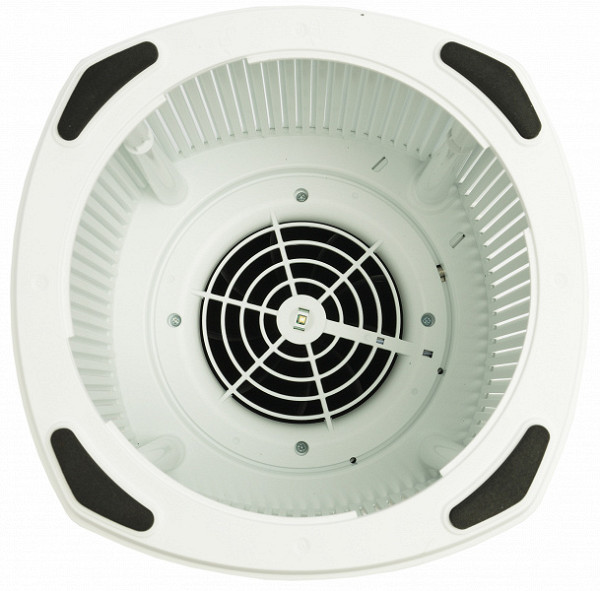
The inner surface of the unit is illuminated by a UV LED on the fan grille, which, according to the manufacturer, should disinfect the air and the filter.
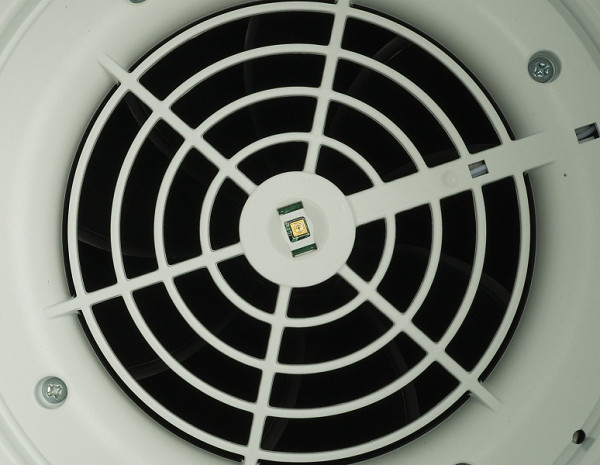
Unlike the older model, which we reviewed not so long ago, the Polaris PPA 2025 has an external power supply that provides the device with a constant current of 1 A and a voltage of 24 V.
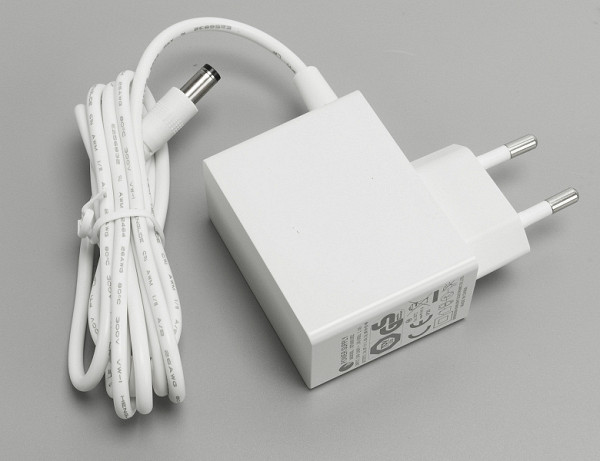
Instructions
The user manual is an A5 brochure printed on thick glossy paper.
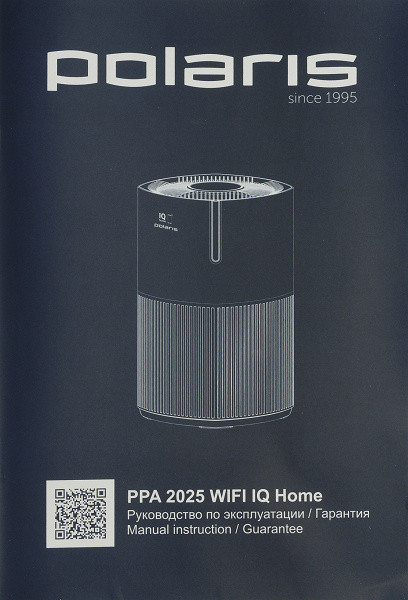
The document is written in two languages: Russian and Kazakh. The Russian-language part takes up exactly half of the 40-page booklet.
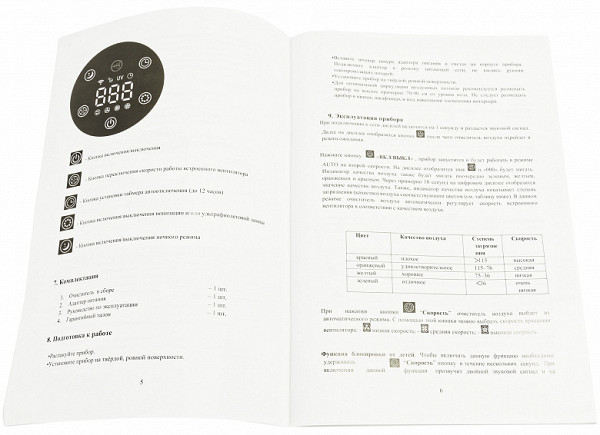
The manual contains detailed instructions on how to prepare the air purifier for use, its operation and maintenance. The document includes recommendations on connecting to the proprietary application, a list of potential malfunctions with methods for eliminating them, as well as detailed technical specifications and warranty conditions.
Control
The air purifier control panel is a round screen made of dark plastic with LED indicators and touch buttons.
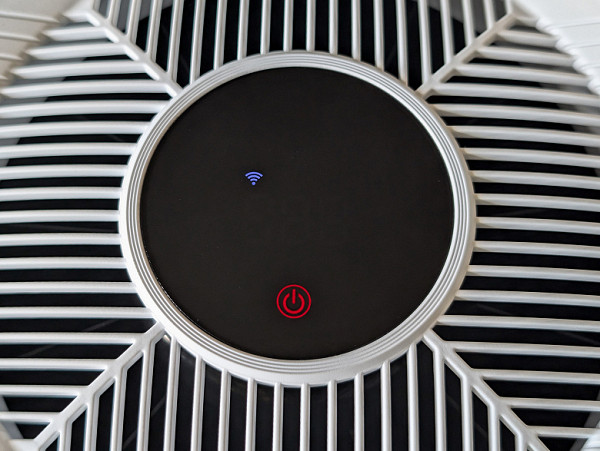
In standby mode, only the «Power» button and, when pairing with a mobile application, the wireless interface activity indicator light up on the screen. Pressing the power sensor activates the display.
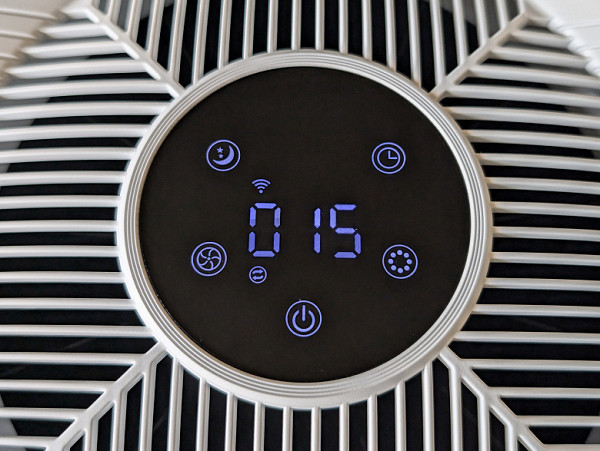
The center displays the readings of the suspended particles sensor (PM2.5) in micrograms per cubic meter of air. Around it are five sensors for controlling the device:
- The «On» button turns the air purifier on and off. A long press activates the pairing mode with the mobile application.
- The «Speed» button switches the fan rotation levels. The device starts in automatic mode, independently determining the power depending on the level of air pollution. If necessary, you can manually select low, medium or maximum speed. A long press turns the child lock mode on and off.
- The «Sleep» button activates the night mode, in which the fan operates at minimum speed, and the display brightness is reduced. A long press (about 3 seconds) completely turns off the indication.
- The «Timer» button adjusts the automatic shutdown time of the device. By successive presses, you can select a time from 1 to 12 hours in 1-hour increments.
- The «Ionization» button controls the built-in ionizer and ultraviolet irradiator. By default, both functions are disabled, and successive presses on the sensor allow you to enable one or both at the same time.
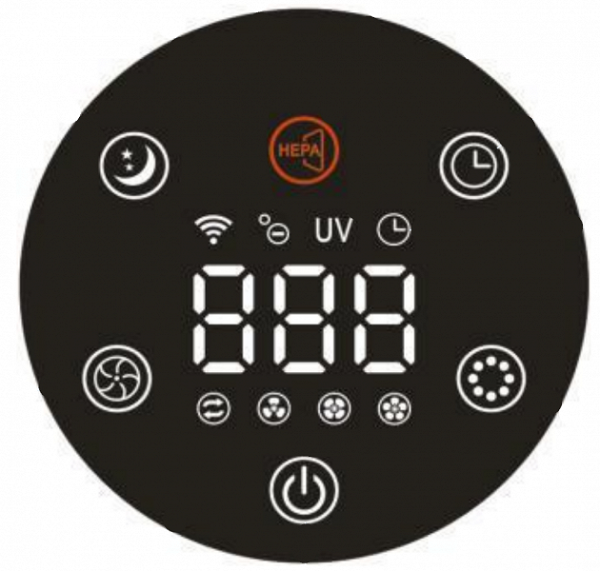
Above the display, indicators for additional functions light up: network connection, ionization, ultraviolet radiation and timer. The bottom row displays the current fan speed.
After 3,000 hours of continuous operation, an indicator appears at the top of the screen, signaling the need to replace the filter.
Control from smartphone
To control the device using a smartphone, the manufacturer offers the Polaris IQ Home application. This is an extensive ecosystem that unites smart home devices, allowing you to access them from anywhere in the world where there is Internet.
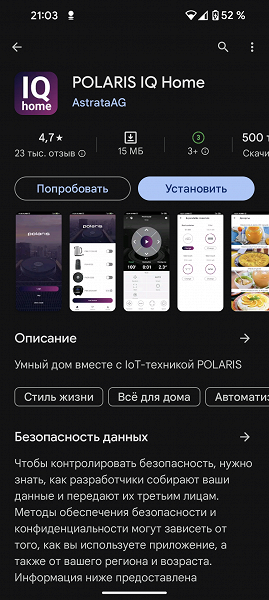
We have already encountered this application in reviews several times and each time we were pleased with its functionality. And this time we did not find any serious shortcomings. But let's not get ahead of ourselves.
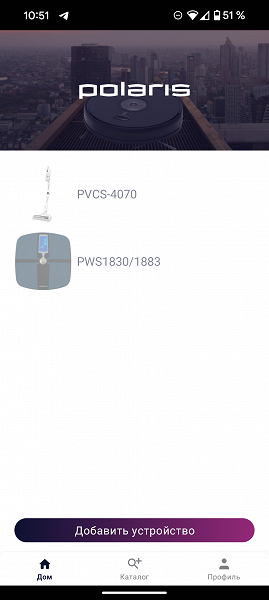
To start working, you need to pass authentication with confirmation of your mobile phone number. After successful login, the main screen displays a list of devices and the «Add device» button, which we will need.
In the list of supported devices, we find Polaris PPA 2025 and check that our air purifier is turned on. Next, the application explains step by step how to enable pairing mode.
The entire procedure takes no more than a minute and is completed without any difficulties.
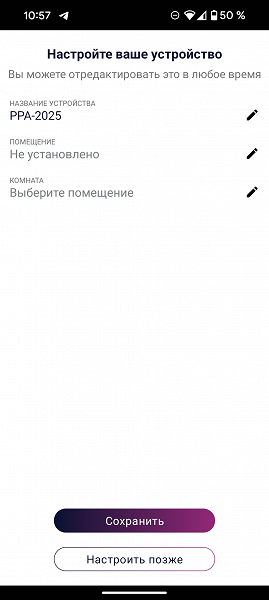
At the final stage, the user is asked to rename the air purifier to his taste and assign the room in which it will work.
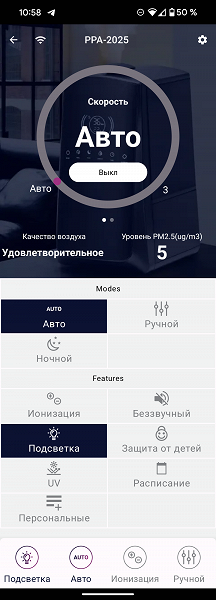
The main screen of the application is divided into two sections. The upper part displays the current parameters of the microclimate in the room, and in the lower part you can select the operating mode of the device and activate additional functions, such as turning on or off the backlight and sound, child protection, ionization, UV irradiator and night mode.
By default, as already mentioned, the air purifier operates in automatic mode. If desired, you can manually set the fan speed using the round slider. The buttons at the bottom of the main screen partially duplicate the «tiles» in the center of the interface. Despite the slight redundancy of the user interface, this does not interfere with convenient control.
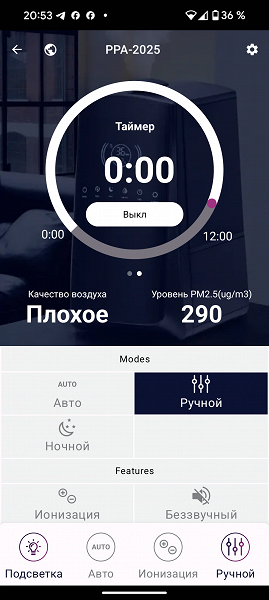
The same slider is used to set the time for automatic shutdown of the device.
The «Schedule» link opens an editor for creating scenarios for the device to operate at a certain time of day and selected days of the week. We found it convenient to switch the air purifier to night mode exactly at midnight and start it automatically in the morning: on weekdays at nine in the morning, and on weekends, when you want to sleep longer, at eleven.
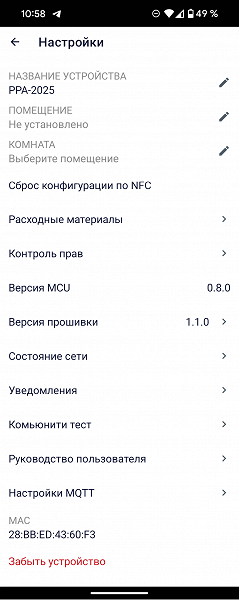
In the settings section, the user can change the name of the device, reassign it to another room, update the firmware, or grant control of the device to another family member (the new user, of course, must have the IQ Home app installed).
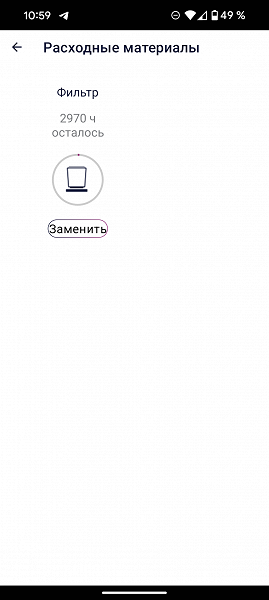
On the «Consumables» page, you can check the remaining filter life and reset the service interval when replacing the consumable.
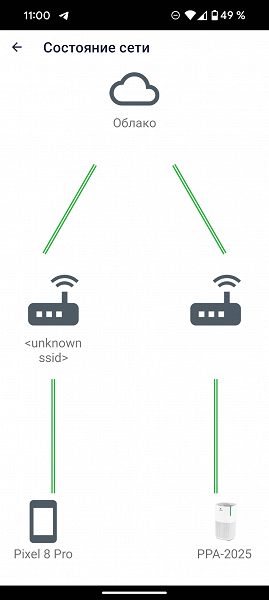
In case of various network problems, the application provides a visual diagram that helps to identify the problem.
In the settings section, we noticed an interesting item «MQTT settings», which was not found in previous Polaris devices. However, unfortunately, the ability to integrate the air purifier with the MQTT server was removed after the firmware update. We regret this and hope that the developers will return this function at least in experimental mode, since integrating the device into an autonomous smart home system without dependence on cloud services would significantly expand its functionality.
Operation
As usual, let's start by unpacking the device. As a reminder: do not forget to remove the protective film from the filter element.
Now you need to choose a flat and hard surface for the air purifier. For optimal air circulation, the manufacturer recommends installing the device at a height of 70-90 cm from the floor, avoiding placing it in niches, cabinets or under hanging elements.
After connecting to the network, the device emits one beep and goes into standby mode.
When you press the «Power» button, you will hear another short beep, after which the fan will turn on and the air quality sensor will begin calibrating. This process takes about 10 seconds and ends with the current readings being displayed on the display.
If the power supply is disconnected, the model will have to be reconfigured. Even if the power supply is briefly disconnected, the Polaris PPA 2025 returns to standby mode and does not save the previous settings.
In automatic mode, the device automatically selects the power level depending on the air pollution. The parameters at which switching occurs are specified in the documentation.
| Indicator color | PM2.5 sensor readings, µg/m³ | Air quality | Speed |
|---|---|---|---|
| red | >115 | bad | high |
| orange | 115-76 | satisfactory | average |
| yellow | 75-36 | good | low |
| green | <36 | excellent | very low |
The minimum («very low») speed can only be set by the air purifier in night mode. Low, medium and high speeds are available in manual switching.
In manual and automatic modes, the fan speed changes smoothly, although the transitions are clearly audible. If the pollution level increases sharply, the device reacts almost instantly, increasing the power, since it accesses the air quality sensor every few seconds.
When changing the speed, the LED air quality indicator also changes color.
The device's readings are easy to read both in complete darkness and in bright sunlight.
The device is intuitively easy to operate; all functions function clearly and predictably, eliminating possible difficulties in everyday use.
Care
When the total operating time of the device reaches 3000 hours, a warning symbol appears on the display indicating that the filter needs to be replaced. The cartridge cannot be cleaned or serviced; it must be replaced entirely.
We discussed the availability of consumables with the company representatives. They assured us that filters will be available, but later, since the device is new and there is no need for them at the initial stage of sales.
After replacing the filter, you need to reset the service interval. This can be done by long pressing the «Timer» button or in the application.
Regularly clean the inlet and outlet grilles of the device from dust with a soft dry brush. The use of solvents or abrasives is not recommended.
Our measurements
The power consumption and noise of the device depend on the fan operating mode.
| Speed | Night mode | I | II | III |
|---|---|---|---|---|
| Power, W | 2,2 | 7.4 | 8.3 | 21.8 |
| Noise, dBA | 36 | 45 | 51 | 62 |
Activating the UV backlight and ionizer does not have a noticeable effect on the power consumption of this model, remaining within the permissible measurement error. In standby mode, the device connected to Wi-Fi consumes about 1 W.
To test for maximum performance, we connected a 260 mm diameter, 1 meter long ventilation pipe to the outlet grille, carefully insulating the connection.
Using an anemometer, we measured the air flow velocity at the outer opening of the pipe at 17 points. The average value was approximately 1.37 m/s, which with a 260 mm duct diameter corresponds to a performance of 4.37 m³/min or 262.24 m³/hour.
Practice tests
Air purification, maximum performance
To evaluate the filtration efficiency of Polaris PPA-2025, we filled a test room (approximately 2.1 x 2.1 x 2.4 meters, which corresponds to a volume of 10.5 m³) with smoke generated by a homemade smoke generator to such an extent that “you couldn’t see your fingers on an outstretched hand.” To measure the concentration of suspended particles, we used the SDS011 optical sensor, which is capable of detecting PM2.5 up to 999 μg/m³ and PM10 up to 1999 μg/m³. These values were taken as the maximum.
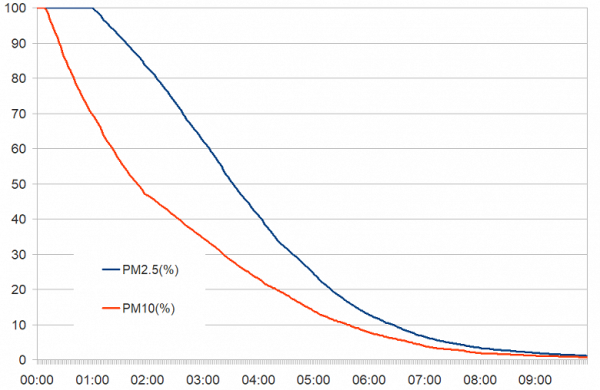
When running at maximum performance, the Polaris PPA-2025 air purifier reduced PM2.5 pollution levels to 50% of the maximum in 3 minutes 30 seconds. In 8 minutes 12 seconds, the concentration of suspended particles dropped to an acceptable level of 30 μg/m³. Pollution with larger PM10 particles was reduced even faster.
After ten minutes of operation at maximum power, the PM2.5 and PM10 content was a safe 11.2 and 13.5 μg/m³, respectively, while with natural settling, the air pollution level would remain extremely high, exceeding the maximum sensitivity thresholds of the sensor: 999 μg/m³ and 1999 μg/m³.
Air purification, minimum mode
When operating at maximum power, the device demonstrated excellent efficiency. But for the sake of completeness, we will conduct an additional test — we will evaluate the performance at minimum speed.
To compare the efficiency of air purification using an air purifier and natural settling of particles, we repeated the experiment by turning off the device. Then we observed how quickly the particles settled without any intervention. The results are presented in the graph.
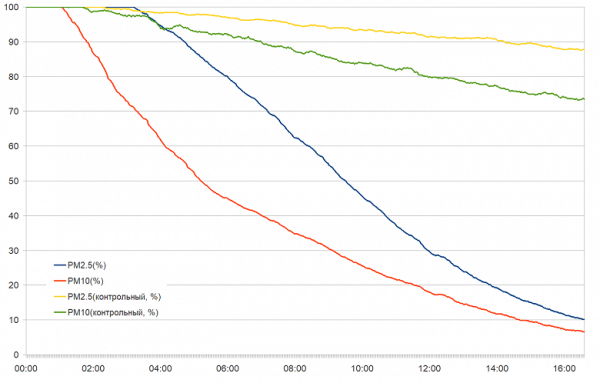
In the quietest mode, where power consumption is reduced seven times compared to the maximum, the efficiency also drops, but the device still continues to purify the air.
It took the device 9 minutes 30 seconds to reduce the concentration of PM2.5 particles to 50% of the initial level, and after 15 minutes the concentration reached a safe 14.9 μg/m³. Pollution with PM10 particles, as in the previous test, decreased much faster.
| Maximum performance | 262 m³/h |
|---|---|
| Maximum noise level | 62 dBA |
| Reduction of PM2.5 pollution by 50% of maximum, min:sec | 3 minutes 30 seconds |
| Air pollution level of PM2.5 particles after 10 minutes of operation | 11.2 µg/m³ |
| Maximum power consumption | 21.8 W |
Conclusions
The Polaris PPA-2025 WiFi IQ Home air purifier combines high efficiency and economy. A powerful fan and high-quality filtration allow you to quickly clean the air to safe levels.
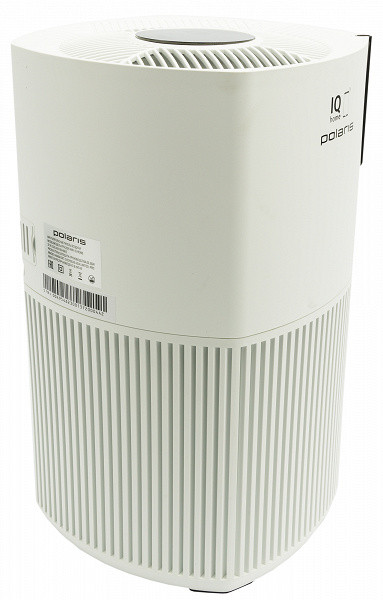
The Polaris PPA-2025 WiFi IQ Home model is equipped with a microparticle sensor that allows you to automatically adjust the power depending on the level of air pollution. Additional functions such as ionization and UV disinfection make the device even more versatile. It is controlled via a convenient application accessible from anywhere in the world.
This air purifier is perfect for small rooms and studio apartments. For more spacious rooms, it is better to choose the older model from the line that we recently reviewed.
The only drawback is the increased noise level in night mode, which can be inconvenient for light sleepers if the device is installed in the bedroom.
Pros:
- good filtration efficiency
- convenient control from a smartphone
- air quality sensor ensures efficient operation in automatic mode
Cons:
- relatively high noise at minimum power

